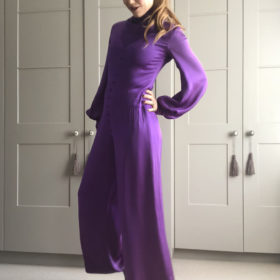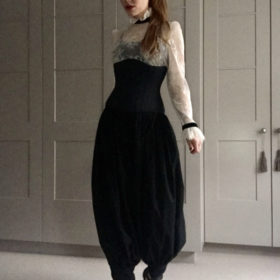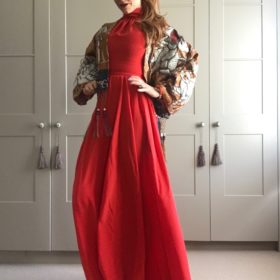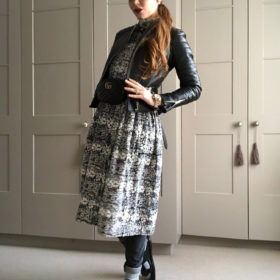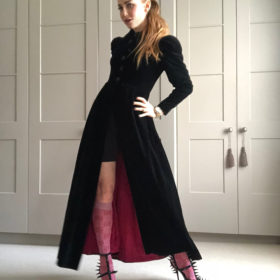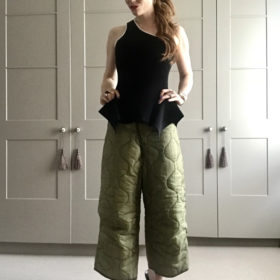How to buy, alter and style vintage fashion
My seven top tips for buying, altering and styling vintage fashion – the ultimate cool, sustainable way to shop.
I get the BIGGEST fashion buzz when buying vintage and especially at the Clerkenwell Vintage Fair in London. I’ve found myself elbow to elbow with designers, stylists and fashion editors rummaging those rails. There’s everything from Dior to Chanel and Biba and something for every budget. Watch the video as I trawl the fair and uncover a few special vintage gems and scroll down for my top seven tips for converting vintage…
There are so many amazing clothes out there already, we don’t have to shop the high street every time we want something new. Vintage is where its at. There’s a knack to buying and styling vintage so here are my seven top tips for working vintage fashion:
1. Size doesn’t matter – try everything on
The sizing on vintage clothes is not the same as the sizing we have today. Don’t let it put you off – try it on anyway. If you love it, there’ll be a way to make it fit and flatter you – see my tips below. At Clerkenwell there is a resident seamstress at the fair to advise on, and make alterations while you wait! BRILLIANT.
2. Making clothes smaller
The rule of thumb is…if you love it but it’s too big, buy it and get it altered to fit.
 It’s easy to make clothes so don’t be put off by the size. Remember, you don’t need to be able to sew. A skilled seamstress or a tailor at your local dry cleaners will be able to do the alterations for you. Here are a few ideas on how to alter vintage fashion:
It’s easy to make clothes so don’t be put off by the size. Remember, you don’t need to be able to sew. A skilled seamstress or a tailor at your local dry cleaners will be able to do the alterations for you. Here are a few ideas on how to alter vintage fashion:
- If a piece is slightly baggy in places, you can easily nip it in with darts or take in the sides and back
- Make trousers more tapered and defined by taking in the outside or inside seam. You can also take in a baggy bottom.
- Remove excess bulk and create a cleaner silhouette on the bodice by repositioning zips.
- Take in the side seams on skirts, dresses, jackets and coats.
- Take in armholes using small darts or by taking in the sides.
- A full length sleeve can be shortened to ¾ length or turned into a cap sleeve or removed altogether.
Potential snags: Try to ensure the shoulders are the right fit for you because they can be tricky to alter. Likewise, altering a sleeve that’s already cuffed or buttonholed isn’t always straightforward, but there are ways around it.
3. Making clothes bigger
The rule of thumb is…if it just about does up, check the seam allowances and get your dressmaker to let out. Be prepared to add panels if it doesn’t quite do up – which can actually look very cool.
Pre-1970s vintage fashion was often made with large built-in selvedges or seams so clothes could be converted to fit us as our body shapes changed. The dream conversion scenario!
 Here are a few top tips for letting out vintage clothes:
Here are a few top tips for letting out vintage clothes:
- Replacing or moving a zip can add an up to an extra 1 inch on a dress (depending on the seam allowance and style of zip).
- Letting out selvedge edges, darts, pleats and ruffles will create that crucial extra space.
- If you need more than the seam allowance will give, you can insert strips of fabric or panels down the sides of trousers, tops or dresses to create extra room.
- Armholes on vintage dresses are often tight in comparison to what we’re used to today but it’s fairly easy to let them out to give extra movement.
- If the waist is too tight, skirts can often be shortened from the top to increase the circumference and make them fit.
- You can remove or replace tight waistbands with bias binding or elastic.
Potential snag: Avoid letting out velvet and taffeta because the old stitch line will show on these fabrics.
4. Ask the stall holder about the provenance
This isn’t just about shopping. Every vintage piece has a story and stall holders always stories to tell about where the piece came from! I found a suit lined with WWII parachute silk, a note from the bride inside her wedding handbag from 1923 and the entire clothing collection of a Norman Hartnell model. Take your time and relish the experience.
5. Make vintage fashion contemporary

You can take your vintage clothes to a whole new level by giving them contemporary tailoring conversions:
- Adding a new exposed zip down the back of a vintage dress or jumpsuit instantly adds a modern twist.
- Changing the buttons can completely change the vibe of the outfit.
- Embellishing an item with contemporary ribbon gives it a ‘now’ look.
- Altering the hem length, style of the collar and the length/width of the sleeves will modernise any piece.
Contemporary styling is key:
- A wide belt on a vintage dress, or even on a jacket, will add a modern edge and create a defined silhouette.
- Adding a cool, modern brooch will lift an outfit especially if you go for one that’s plain but has an interesting shape.
- Go for edgy heels or a sporty look eg high tops, trainers.
- Keep your jewellery simple and modern.
For contemporary accessories I go to: VV Rouleaux, Kleins, and MacCulloch & Wallis
6. It’s where the stylists and designers go
Stylists and designers trawl the vintage shops and fairs for next season’s inspo. True style starts with vintage. Grab the pieces that reflect what’s happening on the catwalk and add a contemporary twist. You can wear them with pride – you found them at source!
7. Buying vintage is being ‘fashion conscious’
There are so many incredible clothes already out there that just need a small conversion to fit and flatter you perfectly. Next time you need a new outfit why not try buying vintage fashion before heading to the high street? You’ll look unique, stylish and everyone will be asking you where you got your outfit from. Guaranteed.
Here are a few of my favourite vintage finds:
- Jean Muir vintage purple jumpsuit
- Vintage black harem pants
- Vintage Chinese jacket
- Vintage Laura Ashley prairie dress
- Vintage black velvet opera coat
- Vintage sleeping bag trousers
Follow my blogs and leave me a comment below if you need inspiration for converting a vintage find – I’d love to help!
To watch more videos about fashion, sustainability and converting clothes, follow Converted Closet on YouTube.
Thanks to Nanna of Splendid Stitches for her tailoring contributions. Splendid Stitches is London’s only dedicated specialist vintage fashion alterations and repairs service. Instagram @splendidstitches

